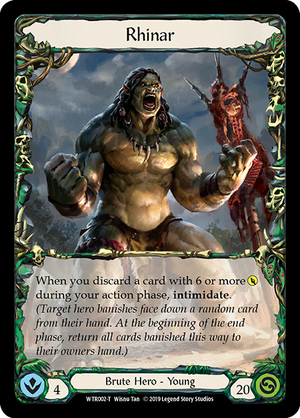FAB 101: Welcome to Rathe Classes
Flesh and Blood currently features eight “full classes” and two special cases. I’m going to be posting a quick review of how each class plays — this is probably pretty basic information for more experienced players, but is aimed towards helping newcomers understand how different characters work. (Don’t worry, more advanced content is coming later!) We’ll start with the four classes introduced in Welcome to Rathe, with a second article discussing the Arcane Rising classes and then another for the “special cases” from Crucible of War. Let’s get into it!
Rhinar (Brute)
Brute is a class focused on making strong attacks. Unlike some of the other classes, Brute also has several mechanics that are luck-based in nature, including cards with random discards as an extra cost, a class mechanic that has a significant random component, and even some cards that actually roll a die to determine their result! However, you shouldn’t assume that Brute is all RNG — a canny Brute player can play quite a consistent game through strategic pitching/blocking and avoiding unnecessary dice rolls.
The Brute class mechanic is Intimidate, which temporarily exiles cards from your opponent’s hand to limit their options. In conjunction with cards like Bloodrush Bellow, which significantly buff an attack if it is defended by fewer than two non-equipment cards, Brute can potentially punish you for not blocking and then remove your ability to do so! However, Intimidate returns the exiled cards to the opponent at the end of the turn, which means that the advantage you get is temporary — but it gets much more dangerous when players are at low health, since if you’re threatening to kill the opponent giving them cards back afterwards doesn’t matter!
Bravo (Guardian)
Guardian, as the name might imply, is a class with access to heavy defenses. Like Brute, Guardian also likes making strong attacks and limiting the opponent’s options, though Guardian uses Dominate (a mechanic that prevents an opponent from blocking with more than one card from hand) rather than Intimidate to achieve this. However, Guardian’s key attack cards are extremely expensive, which means it can take some setup to get into a position where you can actually deliver big punishment. Guardian also has various “auras” that stay in play for a bit after first being played, allowing you to further “build up” for a big attack later on. On the other hand, even Guardian’s weapons can be heavy hitters, allowing you to block and swing your hammer while waiting for the right moment to make a big attack.
The Guardian class mechanic is Crush — attacks with this mechanic inflict powerful effects on the opponent if they inflict 4 or more damage. This is essentially a stronger but harder to achieve version of an “on-hit” effect and pairs well with Dominate and/or aura effects in order to ensure damage is coming in — when playing against Guardian, it can be useful to save defense reactions (especially in arsenal) for stopping potential Crush effects.
Katsu (Ninja)
Ninja is a class that focuses on using go again to do lots of stuff in a turn! The agile Ninja can outmaneuver an opponent with lots of attacks in a turn and keep them guessing about what a turn will include. Even Ninja’s basic weapon attacks can have go again! On the other hand, Ninja’s defenses are weaker than most, with several cards (including many staples) blocking for only two damage rather than three. This means that even moreso than other classes, Ninjas who lose momentum can sometimes find themselves in a fairly desperate spot.
The Ninja class mechanic is Combo, which buffs certain attacks if they are played after other attacks. Ninja has several “combo lines” of cards that should be played one after for a powerful effect, often culminating with a very strong ability on the last card of the combo! However, if you aren’t able to assemble the combo these cards can be a bit below par, so plan accordingly when deckbuilding and playing!
Dorinthea (Warrior)
My preferred class! Warrior focuses primarily on making weapon attacks, with no in-class attack actions whatsoever but a lot of cards that buff weapons. Some of these, like Sharpen Steel or Warrior’s Valor, buff the weapon outside of the combat chain, but Warrior also features a lot of attack reactions, which can make defending against their attacks more ambiguous and difficult. Additionally, Warrior has a fair amount of on-hit effects, which makes defending properly more important! It can be difficult to know what the best tack to take when defending against a Warrior is — if you defend normally, they might be able to get in with an attack reaction to trigger their on-hit effect anyway, but if you “overblock” it limits your options and they can hold a potential reaction back.
The Warrior class mechanic is Reprise, which allows some attack reactions to gain effects if used after an opponent blocks from hand. This mechanic can be powerful under the right circumstances, but the opponent can sometimes prevent it from triggering by defending with only equipment and/or defense reactions from Arsenal.
So there you have it — brief overviews of the four hero classes available in Welcome to Rathe. These are probably the best options for a newcomer to choose from when first learning the game, as their mechanics are less complicated than those of the Arcane Rising classes — if none of these catch your fancy though, try checking out the next article, which reviews the new hero classes from Arcane Rising!
(Flesh and Blood and its card art is © Legend Story Studios.)




